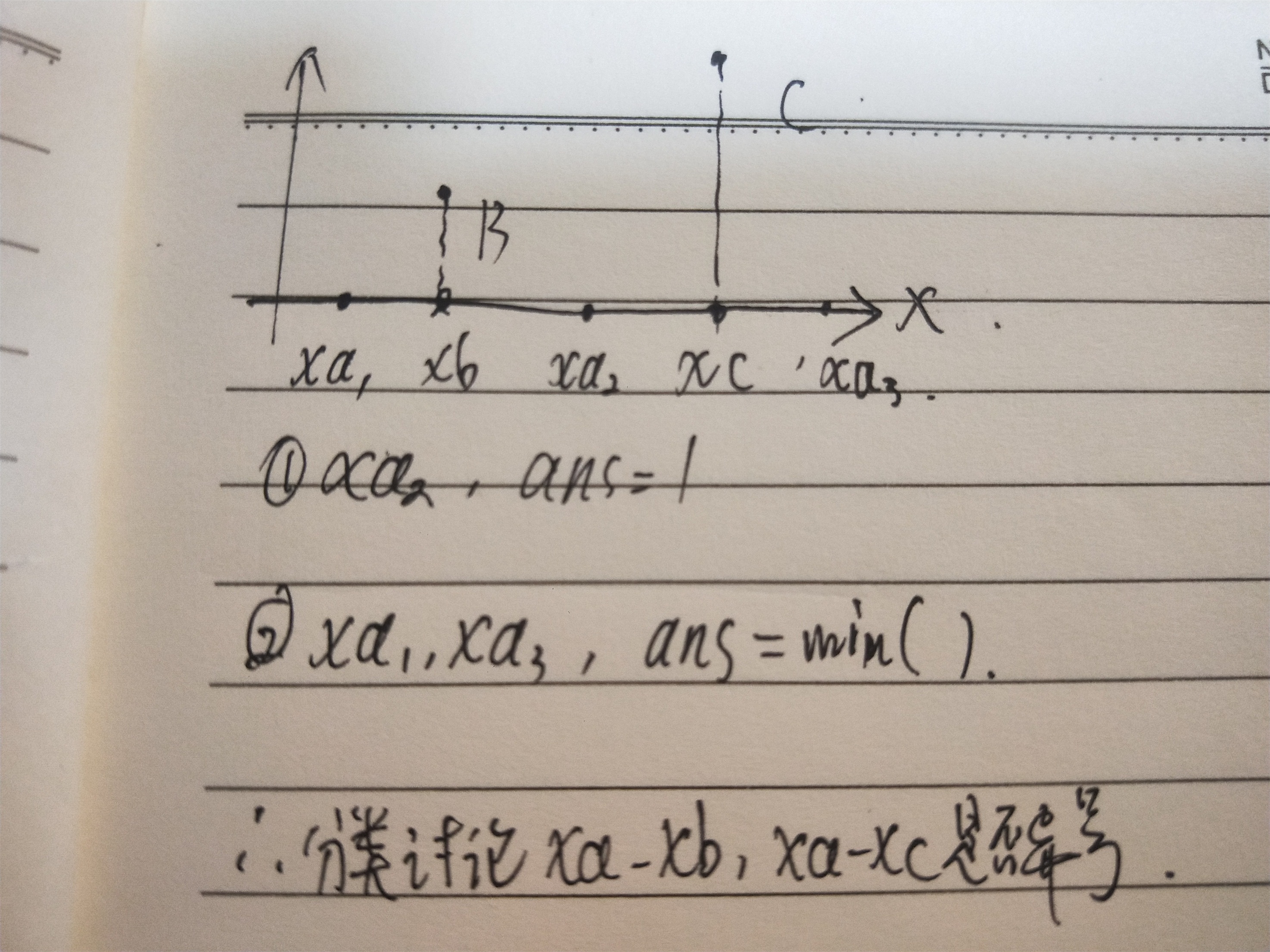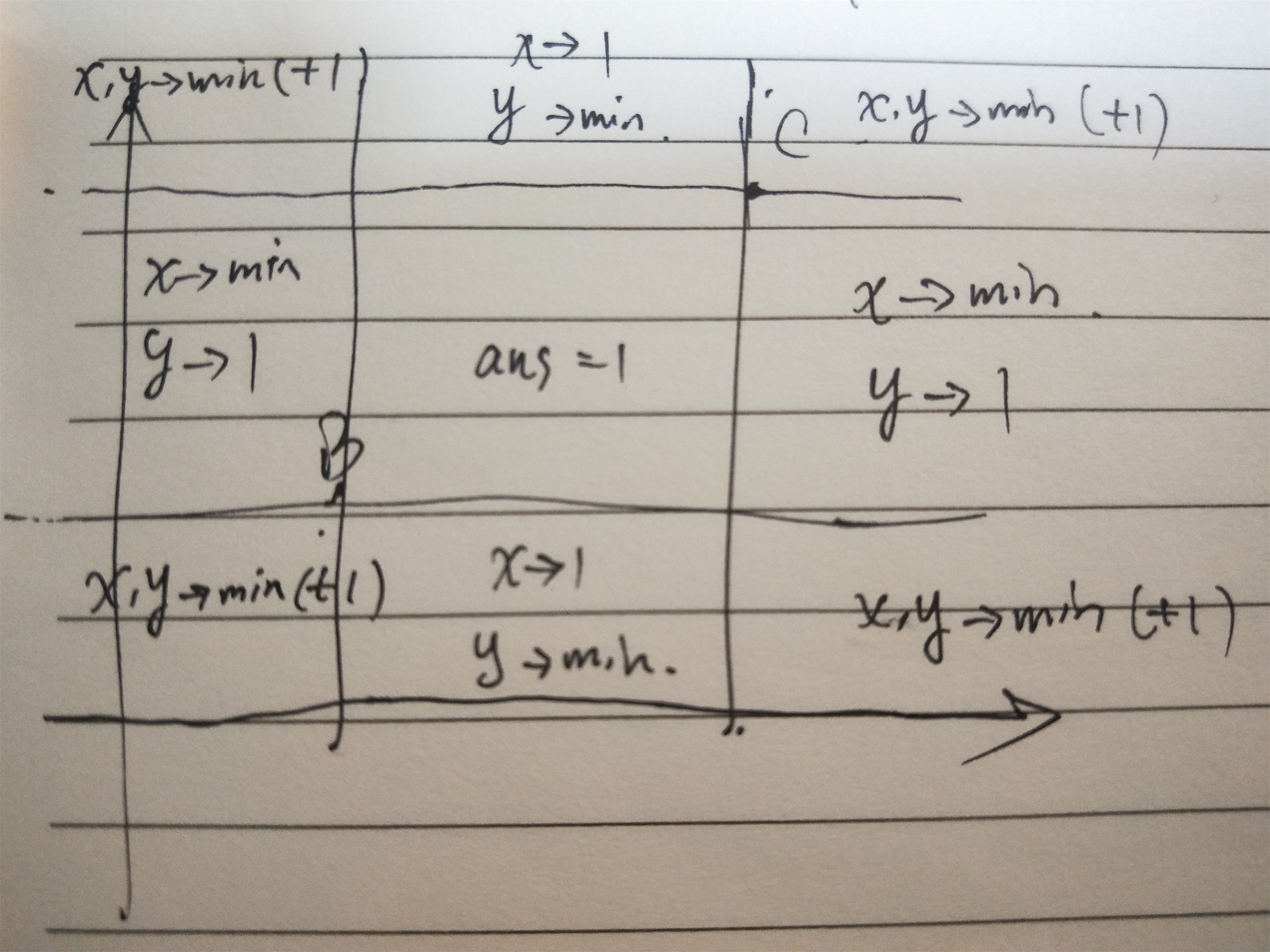link
\(\textcolor{52C41A}{A}-\textcolor{FADB14}{B}-\textcolor{FADB14}{C}-\textcolor{E74C3C}{D}-\textcolor{E74C3C}{E}-\color{E74C3C}{F}\)
A
给你一个数 n ,在给你一个数列 1~k,其中 x 不能用,然后用其他的数任意累加,如能得到 n ,输出所用数字数量和具体数列。
一眼分类。先分是否有 1,有 1 就皆大欢喜;
没 1,那就是可以用 2~k,此时就只要分两种情况:1. k=2,2. k>2 ;
为什么这样分?因为当 k>2 时,就可以用 2,3 组合成所有的数啦。 done.
#A code
#include <bits/stdc++.h>
using namespace std;
const int N = 110;
int t, n, k, x;
int main()
{
ios::sync_with_stdio(false);
cin.tie(0);
cout.tie(0);
cin >> t;
while (t --)
{
cin >> n >> k >> x;
if (k == 1 && x == 1) { cout << "NO" << endl; continue; }
if (x != 1) //1
{
cout << "YES" << endl << n << endl;
for (int i = 1; i <= n; i ++) cout << 1 << ' ';
cout << endl;
}
else
{
if (k == 2) //2
{
if (n % 2 != 0) cout << "NO" <<endl;
else
{
cout << "YES" << endl << n/2 << endl;
for (int i = 1; i <= n/2; i ++) cout << 2 << ' ';
cout << endl;
}
}
else //2 or 3
{
cout << "YES" << endl;
if (n % 2 == 0)
{
cout << n/2 <<endl;
for (int i = 1; i <= n/2; i ++) cout << 2 << ' ';
}
else
{
n -= 3;
cout << n/2+1 << endl;
for (int i = 1; i <= n/2; i ++) cout << 2 << ' ';
cout << 3 << endl;
}
}
}
}
return 0;
}
B
在 Oxy 的 Ⅰ 象限,给出三个不同的点 A,B,C,规定 A 为起点,其余为两个终点,求分别从起点到终点的两条最短路径的最大重合长度。
一开始受上题影响,且一眼没思路,我就又开始分类讨论,分出了四五种情况,越分越复杂......
然后我Q了一下 syz 大佬,发现自己还是一比赛就降智 qwq
两点最短距离就是 xa-xb,xa-xc(y同理,这个就叫做『曼哈顿距离』),
接下来就是分类讨论

然后考虑 A 在 B,C任意位置(xb≠xc,yb≠yc)下不同位置的性质

可以发现,+1 是所有答案的共有性质,即肯定重合在 A 点,
那么就是判断 x,y 分别是否异号即可(用相乘判断,注意开 long long ,一直被劝告,永远在忘记) done.
#B code
#include <bits/stdc++.h>
using namespace std;
typedef long long ll;
int t;
struct node
{
ll x, y;
}a, b, c;
ll count(ll & beg, ll & end)
{
return beg - end;
}
int main()
{
ios::sync_with_stdio(false);
cin.tie(0);
cout.tie(0);
cin >> t;
while (t --)
{
cin >> a.x >> a.y >> b.x >> b.y >> c.x >> c.y;
ll lbx = count(a.x, b.x);
ll lby = count(a.y, b.y);
ll lcx = count(a.x, c.x);
ll lcy = count(a.y, c.y);
ll ans = 0;
if ((lbx * lcx) > 0) ans += min(abs(lbx), abs(lcx));
if ((lby * lcy) > 0) ans += min(abs(lby), abs(lcy));
cout << ++ ans << endl;
}
return 0;
}
C
给一个由 0~9 组成的字串 s、一个数 m、两个长度为 m 的字串 l,r ,求是否存在一个数满足在 [l,r] 范围内且不是 s 的子串(不一定是连续的)
- 首先想到肯定要枚举 l,r ,按从高到低数位 l -> r (不论是否连续,严格从左至右)
那对于 l -> r 的每一个数位,又肯定要在 s 上查询,看看能否找到;
没找到,那就说明肯定不是它的子串;
-
找到了,那就标记该位置,为什么嘞?其一是把 \(l[i] \rightarrow r[i]\) 中的所有被标记的位置找到,取其中的最大值,即最靠近 s 的尾巴,这样下一数位的数出现在 s 上的可能性就最小(别忘了严格从左至右,所以 s 标记处的左边就没有再遍历的意义了,所以我这样结论),这是一种贪心思想;
其二是也从刚刚的话看得出来,标记最远位置 x 后,下一位数就可以直接从 x+1 位开始查询; -
那么答案就从最大值这里切入,若是它的子串,最大值撑死了就是 s 的长度。
so,若不是子串,我们就可以给它赋一个极大值作为在 s 上找不到的标志(其实大于 s 的长度就可以。 done.
顺便提一嘴关于复杂度,Alex_Wei 大犇昨天在 帖子 里回答我说是 \(O(m*m*ls)\Rightarrow O(3*10^7)\) ,是我糊涂了吗(一定是)?,难道测试用例数量 t 不用算进去......
#C code
#include <bits/stdc++.h>
using namespace std;
const int inf = 0x3f3f3f3f;
int t, m;
string s, l, r;
int main()
{
ios::sync_with_stdio(false);
cin.tie(0);
cout.tie(0);
cin >> t;
while (t --)
{
cin >> s >> m >> l >> r;
int ls = s.size(), check = -1;
for (int i = 0; i < m ; i ++)
{
int k = check;
for (char c = l[i]; c <= r[i]; c ++)
{
int tmp = inf;
for (int j = check+1; j < ls; j ++)
{
if(s[j] == c)
{
tmp = j;
break;
}
}
k = max(k, tmp);
}
check = k;
}
cout << (check == inf ? "YES" : "NO") << endl;
}
return 0;
}
剩下 D,E,F ,不用看了,我有自知之明,肯定不会做 qwq
总结:
这场比赛赛时实际上只过了 A ,但只花了 20min 左右,还是比较快的;
剩下的时间完全就耗在 B 上,思路蛮简单,但我的代码写得很......可以说凌乱,导致我一直能发现漏洞,一直调试,一直 wa ,不断堆砌代码,最后调不出来......
#B 凌乱的代码
#include<bits/stdc++.h>
using namespace std;
int t;
struct node
{
int x, y;
}a, b, c;
int count(int & beg, int & end)
{
return beg - end;
}
bool check()
{
if ((a.x >= b.x && a.x >= c.x && a.y >= b.y && a.y >= c.y) || (a.x <= b.x && a.x <= c.x && a.y <= b.y && a.y <= c.y)) return true;
return false;
}
int main()
{
ios::sync_with_stdio(false);
cin.tie(0);
cout.tie(0);
cin >> t;
while (t --)
{
cin >> a.x >> a.y >> b.x >> b.y >> c.x >> c.y;
int lbx = count(a.x, b.x);
int lby = count(a.y, b.y);
int lcx = count(a.x, c.x);
int lcy = count(a.y, c.y);
int ans = 0;
bool ikun = false , IKUN = false;
if ((lbx ^ lcx) < 0) ans += 1;
else
{
ans += min(abs(lbx), abs(lcx));
if (check()) ikun = true;
}
if ((lby ^ lcy) < 0) ans += 1;
else
{
ans += min(abs(lby), abs(lcy));
if (check()) IKUN = true;
}
if (ikun && IKUN) ans ++;
cout << ans << endl;
}
return 0;
}
剩下没多少时间了,就懒得看 C 了。(直接开摆
但赛后看 C 还是蛮简单的。
- Educational Codeforces contest Round 1845educational codeforces contest round educational codeforces round rated educational codeforces round 151 construction educational codeforces round cf-educational educational codeforces round educational codeforces round 147 educational codeforces round 158 educational codeforces monsters round educational codeforces balance round educational codeforces round 119